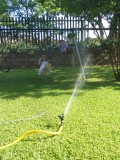How to Prepare for Rain

Introduction
The best thing to do during a rain storm is curl up on a couch with a good book and cup of coffee. The worst is to run outside to clean out a plugged gutter, or mop up a wet basement. By preparing before the rain comes, you can enjoy watching the rain from inside a dry house.
1. Inspect and Clear Rain Gutters and Storm Drains
The most important step to take before a rain storm is to inspect your home's gutters and drains, and clear out any leaves, branches or other debris. These systems allow water to drain away from your home. If plugged, the water will find the path of least resistance--even if it passes through your home.
2. Insure Downspout Extensions are in Place
Make sure any downspout extensions are in place so water draining from the roof is diverted away from the foundation. The extensions need to divert the water to a part of the yard that's graded away from the house. Alternatively, connect the downspouts to a rain barrel to collect the water for use in a garden or other purpose. Each rain barrel should have a tap at the top for a hose which can direct water away from the foundation in the event the barrel overflows.
3. Grade the Land Away from the Foundation
Grade the land around the home away from the foundation so water runs away from the home rather than collecting against the foundation. Ideally, the land should fall away from the foundation at least 6 inches over the first 10 feet (i.e., a slope of 5%).
4. Inspect Nearby Trees for Dead Branches
Inspect any trees near the house for dead branches that may fall and cause injury or damage during a rain or wind storm. Keep in mind that tree trimming or felling is an extremely dangerous task that should often be performed by professionals.
5. Turn Off Automated Sprinkler System
If you have an automated sprinkler system, turn it off when rain is expected.
6. Caulk Any Cracks in Exterior Windows, Doors or Siding
Inspect the outside of the house to look for cracks where water could intrude. Replace chipped or cracked caulk around windows, doors or vents. Use a mortar sealant to fill cracks between bricks. Look for any gaps in the siding or missing shingles.
7. Lower Water Level in Pool
If you have a pool, lower its water level to prevent overflow. The chlorinated or salted water could damage your grass or plants.
8. Test Sump Pump
If you have a sump pump, test it to make sure its working properly. Consider a backup power system since electricity often goes out during severe storms. Battery backup systems are inexpensive. More expensive solutions include temporary or stand-by generators.
9. Plug Sewer Traps
Plug any sewer traps in the basement to prevent sewer water from flowing into the basement. Many plugs include check valves which allow water to flow in only one direction. If you have a standpipe for your sewer trap, install it properly.
10. Declutter the Basement
Declutter the basement by throwing out things no longer needed. It's easier to throw out papers, carpets, etc. when they're dry. Move remaining items above the basement floor using cement blocks, bricks or shelves if there's a risk of them getting wet. Plastic bins can be used to keep things dry.
11. Stockpile Materials to Dry Out
Have materials on hand to dry out, such as pails, sponges, towels, mops and buckets. For more severe cases, useful tools include wet-dry vacs, portable pumps and fans. In the event of flooding, turn off the electricity if safe to do so, or call for help.








